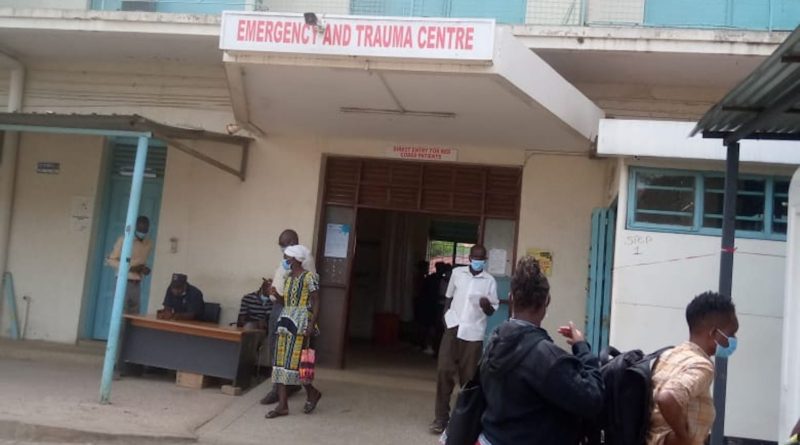JOOTRH’s Casualty Unit, Saviour to Motorbike Riders Prone to Road Accidents
From kisumu.go.ke
by LORRAINE ANYANGO AND FAITH LAWINO
Inside the enormous Jaramogi Oginga Odinga Teaching and Referral Hospital, lay a house section, on top of lintel are inscribed the words “EMERGENCY AND TRAUMA CENTRE”
It is also called the casualty unit. These writings are noted in red, perhaps that rings a bell, maybe it seems scary, but the red colour signifies urgency and immediacy.
The casualty unit at JOOTRH on a daily basis receives victims of road accidents, however most of the time, the unit regularly receives boda boda or motorbike riders who are victims of road accidents.
Despite the challenges, the casualty unit remains to be a light at the end of the tunnel and a savior when the boat seems to capsize. Many boda boda riders both victims and friends of victims, attest to the kind of treatment they have receive from the emergency and trauma Centre.
Joseph Onyango,33, is a motorbike rider and a survivor of a grisly road accident. He is in his 5 months recovery process and is very grateful for what the power of a little needle, the encouragement and attendance of nurses and doctors at Jaramogi casual unit, did to enable him walk again. “I am happy that I can walk again, able to balance on my two feet. I thought I would die, I was unable to walk for weeks and even thought that my limb could be chopped off.” Mr. Onyango said.
“One sad evening, had a head- on collision with an oncoming matatu along the Kisumu- Busia road.”
It was quite dark in the evening and as he attempted to cross the road, he met the untimely accident. The 33 year old rider who is also a father of two, says that he thought the oncoming matatu was still far, but his calculations were wrong.
He woke up to an hospital bed and has detestful memory of that day. He had a broken limb which was threatening to separate from its socket. Nonetheless, Mr. Onyango received good treatment and care which led to his stable recovery.
He is now back to business and does his best to make ends meet.
It never takes one side to tell a story, for there are two sides of a coin. Mr Phillip Bugo is a motorbike rider who usually transport patients to and from the Jaramogi hospital.
He has lived to tell both sad and happy stories of how road accidents has taken away bread winners, families and relatives. He, in not less than one occasion has ferried his fellow motorbike riders to the casualty unit to receive faster assistance after involvement in road accidents.
In most occasions he recalls of good reception and treatments that he has seen the medics offer. However, he talks of some of the gaps that must be filled to make casualty treatment top priority.
Mr. Bugo cannot fail to note them. Most of his fellow riders are ignorant of the rules and some ride under the influence of drug and substance abuse. He joins the clinical Officer Mr. Vincent that motorbike riders at all times should change their ways and obey road guidelines…
According to the Nurse Clinical Officer Mr. Vincent, he tells of his experiences at the casualty unit and how the emergency Centre carries its daily operations.
Significantly, he shares the experiences with road accident victims who are motorbike riders that receive treatment at the casualty unit. The Nurse Clinical Officer who has worked for almost 11 years gives a brief history of the casualty unit.
He says that the emergency and trauma Centre was specifically meant for victims of road accidents but due to nature and unavoidable circumstances, the unit also receives patients with chronic illnesses. The nurses and doctors in the casualty unit also administer to patients suffering from traumas such as epilepsy.
Other illnesses sometimes that are handled at this section include; menengitis, diabetes among other chronic illnesses. The work of these nurses and doctors is to stabilize the patients and afterwards release them to go home
When in good condition they release them or refer them to the wards for further treatment and observation.
During stabilization, the doctors can do bandaging, stitching or first aid services depending on the injury of the patient. The sole responsibility therefore, is to stabilize the patient and get them out of danger as they await further treatment.
The casualty unit holds boda boda riders at a different level, for it is so rare that a week would pass without them receiving a boda boda rider who is involved in an accident. Most of the motorbike riders who are brought in with accident cases are usually hurt in the head and they are brought in severely bleeding.
Patient’s recovery is the casualty unit first priority goal. The section has ambulances which usually pick up accidents victims and deliver them as fast as possible to the unit
Speaking further, Mr . Vincent the clinical Officer says that most boda boda accidents occur due to bad habits. These habits include speeding, riding while drunk and not following the rules that govern using the roads and lastly, most of the motorbike riders are untrained.
It never takes one side to tell a story, for there are two sides of a coin. Mr Phillip Bugo is a motorbike rider who usually transport patients to and from the Jaramogi hospital. He has lived to tell both sad and happy stories of how road accidents has taken away bread winners, families and relatives.
He, in not less than one occasion has ferried his fellow motorbike riders to the casualty unit to receive faster assistance after involvement in road accidents. In most occasions he recalls of good reception and treatments that he has seen the medics offer.
However, he talks of some of the gaps that must be filled to make casualty treatment top priority. There are flaws in the boda boda sector and Mr. Bugo cannot fail to note them.
Most of his fellow riders are ignorant of the rules and some ride under the influence of drug and substance abuse. He joins the clinical Officer Mr. Vincent that motorbike riders at all times should change their ways and obey road guidelines…
This is according to the Nurse Clinical Officer Mr. Vincent, he tells of his experiences at the casualty unit and how the emergency Centre carries its daily operations.
Significantly, he shares the experiences with road accident victims who are motorbike riders that receive treatment at the casualty unit. The Nurse Clinical Officer who has worked for almost 11 years gives a brief history of the casualty unit.
He says that the emergency and trauma Centre was specifically meant for victims of road accidents but due to nature and unavoidable circumstances, the unit also receives patients with chronic illnesses. The nurses and doctors in the casualty unit also administer to patients suffering from traumas such as epilepsy.
Other illnesses sometimes that are handled at this section include; menengitis, diabetes among other chronic illnesses. The work of these nurses and doctors is to stabilize the patients and afterwards release them to go home
When in good condition they release them or refer them to the wards for further treatment and observation.
During stabilization, the doctors can do bandaging, stitching or first aid services depending on the injury of the patient. The sole responsibility therefore, is to stabilize the patient and get them out of danger as they await further treatment.
The casualty unit holds boda boda riders at a different level, for it is so rare that a week would pass without them receiving a boda boda rider who is involved in an accident. Most of the motorbike riders who are brought in with accident cases are usually hurt in the head and they are brought in severely bleeding.
Mr. Vincent says that in cases of head injuries, they do a lot of scanning to ensure no part of the brain is interfered with and that there is no blood clotting. “Usually, we do thorough head scans to ensure the patient is stable and that there are no blood clots in the brain,” says officer Vincent.
The esteemed clinical Officer observes that other injuries that they treat are lower limb injuries, that is from the waist going downwards, the upper limbs-from the waist up to the neck.
The anterior part of the chest rather called the front side of the chest and the posterior part of the chest, that is the back chest. Doctors and Nurses in the casualty understand how sensitive it is to handle motorbike riders who suffer spinal injuries.
According to studies the spinal cord is a very sensitive area which connects from the neck to the lower waist. The medics always have to handle such victims with a lot of care and attention.
Some of the challenges present in the casualty unit are lack of enough resources and personnel. Sometimes, the number of accident victims outweigh resources available leading to lack of enough medics who can attend to all the victims that require immediate attention.





